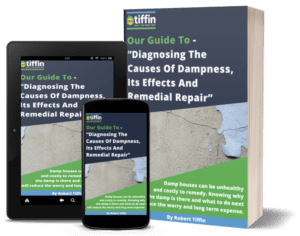Home condensation is the most prevalent form of dampness in domestic properties, causing significant concerns for homeowners, local authorities, and private rental markets alike. Over the past two decades, mould resulting from condensation has become a major source of complaints.
And it’s not just condensation in houses that cause problems – industrial premises, including breweries and food processing factories, also face condensation issues that need rectifying urgently.
Suffering from condensation at home?
Download our FREE eBook guide
What causes condensation at home?
Condensation at home is particularly common during winter months. As external temperatures drop, so does the temperature of your walls. When warm, moist air from inside your home meets these cold surfaces, condensation occurs. Several factors contribute to home condensation, including poor ventilation, heating variations, changes in occupancy, cold bridging, the orientation of the house, and the type of wall construction (solid brickwork or cavity construction). Accurate diagnosis requires consideration of all these factors.
Condensation manifests as water droplets on windows or walls, unpleasant smells, and unsightly black mould, all of which indicate moisture problems in the home.
Key facts about home condensation
- Serious Problem: Dampness and consequent condensation are serious issues in buildings.
- Unpleasant Conditions: Damp properties are generally uncomfortable, unhealthy, and unpleasant.
- Health Risks: Damp and condensation in houses pose serious health risks, especially to young and elderly residents.
- Dew Point: Condensation occurs when warm air meets a cold surface, causing vapor to convert into liquid, similar to steam condensing on a cold kettle.
- Hidden Damage: Condensation in houses often occurs within the building fabric, meaning it can go unnoticed and cause structural damage, such as dry rot, which is costly to treat.
- Insulation and Ventilation: Adding insulation without proper ventilation assessments can exacerbate condensation.
- Air Movement: Restricted air movement behind furniture and cupboards, in roof voids, loft areas, and under floor spaces can lead to condensation and timber decay.
Home condensation
control solutions
Effective home condensation control requires a proper understanding of air movement and moisture production. Here are some strategies:
- Ventilation: Proper ventilation is crucial for home condensation control and should be considered for the entire house.
- Humidistat-Controlled Extract Fans: Install these in bathrooms and shower rooms, preferably heat recovery types.
- Trickle Vents: Install these on all windows to improve ventilation.
- Passive Vents: Add these to exterior walls.
- Cooker Extract Hood: Always use the hood when cooking to reduce moisture buildup.
- Fan Maintenance: Regularly clean and check all fans to ensure they function correctly.
- Furniture Placement: Keep large pieces of furniture two to four inches away from walls to improve air movement.
If your property suffers from home condensation, immediate action is necessary. Contact us today for a thorough assessment, detailed report, and remedial specification to effectively manage and control condensation in your home.
Call back request
If you're looking to cut costs, improve your home's comfort levels, reduce heat loss, get rid of damp or discuss insurance claims, drop us a line and one of our expert team will be in touch.

